When it comes to pet cats, the Bengal Cat is one of the most unique and endearing for you. With their beautiful spotted or marbled coat and friendly temperament, Bengals have quickly become a favorite among cat lovers like yourself.
Not only do they possess an inquisitive nature that can keep you entertained for hours, but their intelligent personalities make them easy for you to train and bond with.
With proper care, these majestic cats will bring years of companionship into your life – making them a perfect choice for any cat lover like you!
However, Bengal Cats require special care to live their best possible life. With the information provided here in this guide, you will be able to give your pet cat the love and attention they deserve!
Breed Overview
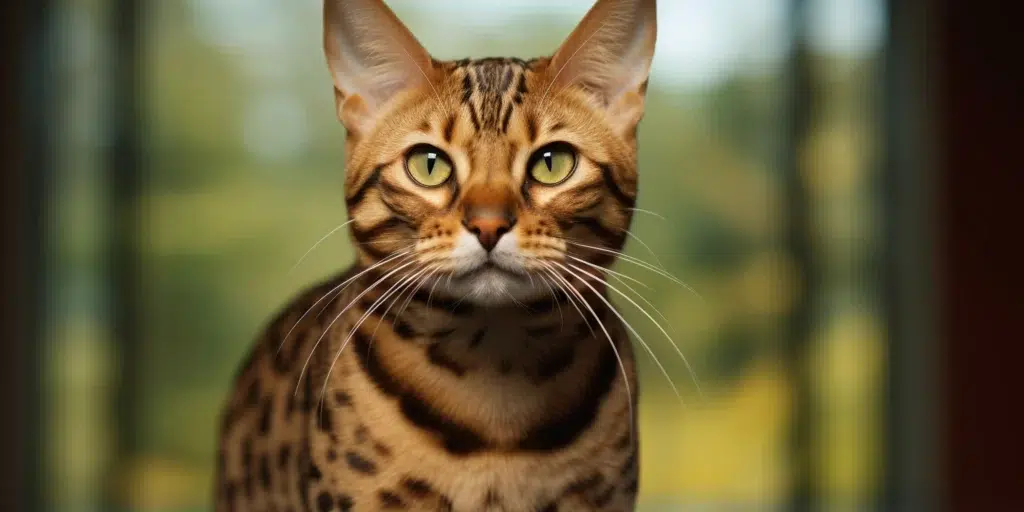
The Bengal Cat, with its stunning spotted coat and large size, is one of the most recognizable breeds in the world.
The breed began as a hybrid between an Asian Leopard Cat (Felis bengalensis) and domestic shorthairs in the 1950s and 1960s.
Dr. Willard Centerwall from Loyola University attempted crossing these cats for research purposes. His leopard cats were resistant to the feline leukemia virus so he hoped that some of their resistance could be passed on to their offspring.
Jean Mill got her hand on some of the crossed kittens and she kept working on them to create the famous Bengal breed.
Soon after, various breeders became interested in creating a new breed from these hybrids – including Jean Mill who continued breeding Bengals until she eventually stopped due to life changes.
It wasn’t until 1986 that The International Cat Association recognized Bengals as a new breed. Since then it has also been accepted by multiple other organizations like the American Cat Fanciers Association, Canadian Cat Association, and CFA.
Bengals have gained immense popularity due to their distinctive appearance combined with their unique personality towards humans. They love being cuddled up on laps and playing around.
If you’re looking for a leopard-looking companion that is both loyal and loving then look no further than Bengal Cats. They may have unique personalities, but are just as amazing as any other house pet out there!
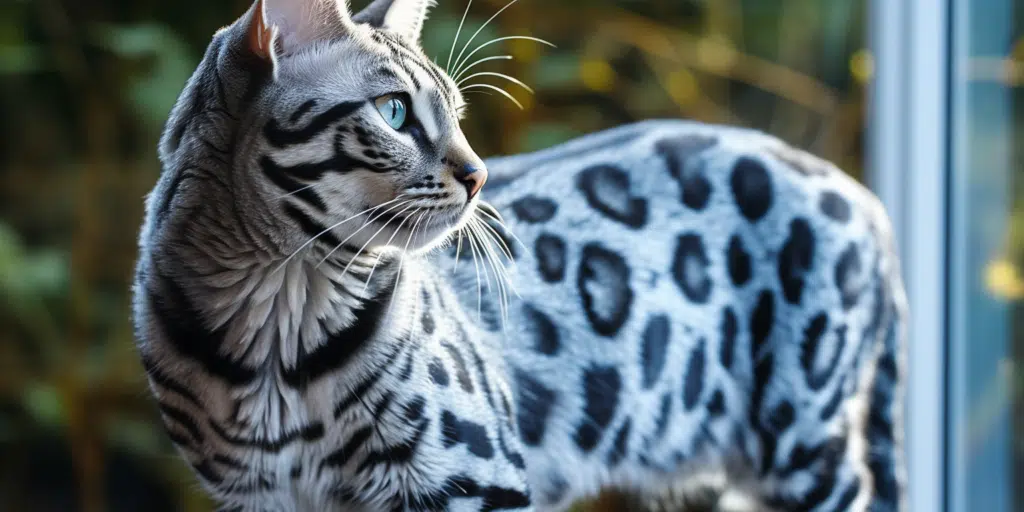
Related: American Cat Breeds That Define the U.S. Feline Fancy
Identifying Bengal Cat
The unique patterns of the Bengal Cat are what makes this breed so incredible and eye-catching. With its luxurious short, soft coat, the Bengal looks, unlike any other cat.
Whether spotted or marble patterned, the Bengal has a distinct look that allows it to stand out in a crowd. The spots on Bengals feature unique patterns that impart an iridescent effect that is highly captivating.
The spotted pattern is most associated with the spots on a leopard. These discernible spots and rosettes can range from small to large.
In addition to rosettes, Bengals may also be marbled which features a swirling pattern of random swirls. They can also look like thick diagonal or horizontal lines flowing across their coat of fur.
This intricate design makes for an especially dramatic appearance that catches the onlooker’s attention when seen up close.
Related: Types of Bengal: Colors and Patterns Unlocked!
The colors of these patterns can vary from one cat to another, and some can feature different shades within each spot. But spots are usually lighter brown in the middle and have a darker outer line covering parts or all around the spot.
Bengal Cats come in a dazzling array of colors and patterns, from cool gray to vibrant shades of golden, bronze, copper, or mahogany. Their spots or marbling range from rich browns to intense black.
Their coats can also feature a unique form of albinism known as “snow”, which gives them an ivory or cream hue with spots or marbling that may range from light brown to dark chocolate.
These one-of-a-kind cats have a white underside that can have dark spots. Truly these cats have it all when it comes to color variations!
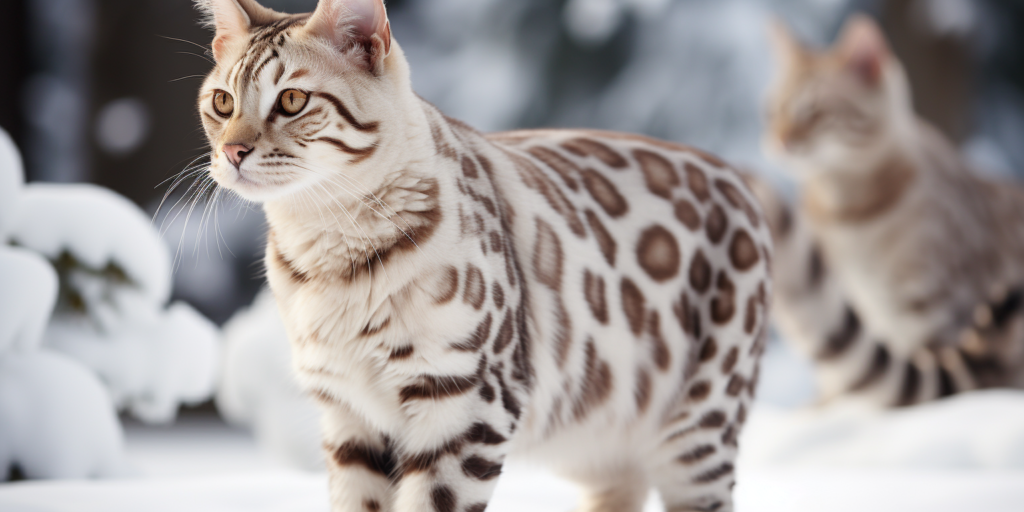
Personality Traits
Bengal cats are known for being active, inquisitive, and highly intelligent. They have an enthusiasm for life that makes them the perfect companion for you if you enjoy an engaging and entertaining pet.
Bengals are friendly, loyal creatures that will follow you around the house, always eager to know what you’re up to. Not only do they love to play with toys, but they also seek out opportunities to explore new places and objects.
Bengals show affection by rubbing against your legs or curling up in your lap when it suits them; however, these cats can often become mischievous if not given enough physical and mentally stimulating activities throughout the day.
As part of their personality traits, Bengals tend to be quite vocal animals; they may meow loudly at various times during the day. Some might also communicate through chirping noises or purring sounds.
Despite this trait being quite common among Bengal cats, it’s still important that you teach your pet Bengal how loud is too loud. You should also teach them to obey simple commands such as “no” or “stop” as they can get too excitable during playtime or start scratching furniture.
Since Bengal cats have a natural curiosity about everything around them, you must keep potential hazards away from prying paws. Things like poisonous plants and potentially dangerous electrical appliances should all be kept away securely.
In your experience, Bengal cats are gentle towards children and love to play with them. They will often show their affection by rubbing up against them or curling up in their laps. But each cat has a different personality, and some might not like to be around children.
When it comes to other animals, Bengal cats have a more laid-back attitude than most breeds of cats. While they may not always get along perfectly with other pets, they tend to coexist peacefully without getting into fights or showing aggressive behavior.
It’s best to introduce a Bengal cat to your family at a younger age so they get used to the atmosphere and the children or other pets you have. This will often result in a very peaceful and loving Bengal cat.
Activity Level
Bengal cats are incredibly active and full of energy. They love to explore, play, and climb on things. With their strong hunting instincts, they may even try to catch birds or small prey outside your home if given the chance!
A bored Bengal cat can become destructive so they must have plenty of stimulating toys and activities available at all times.

When it comes to playing with toys, you might find that Bengals can be very creative in coming up with new games and activities that other breeds might not normally come up with. They also enjoy interacting with you by chasing a laser pointer or feather toy around the house.
In addition to physical activity, they will also require mental stimulation. Puzzles or interactive feeders are great tools for providing mental exercise for your cat.
Additionally, spending quality time bonding with your cat is essential for keeping them content and calm.
Bengal Cat Loyalty
Bengal cats are known for their loyalty and devotion to their humans. They will follow you around the house, waiting for your attention and wanting to be involved in whatever you’re doing.
Bengals love being part of the family and they expect that same level of devotion from you. This breed is known to get depressed if not given enough mental stimulation or if left alone too often. So it’s important to make sure your Bengal gets plenty of quality time with you or other family members.
They tend to form very strong bonds with one particular person within a household. So if you want to be that person, you will have to put in the work and give them the attention they want.
Once they pick a person to bond with, they will often follow them around like a shadow and cuddle up close when they sit down. This is how they show their affection and loyalty to someone.
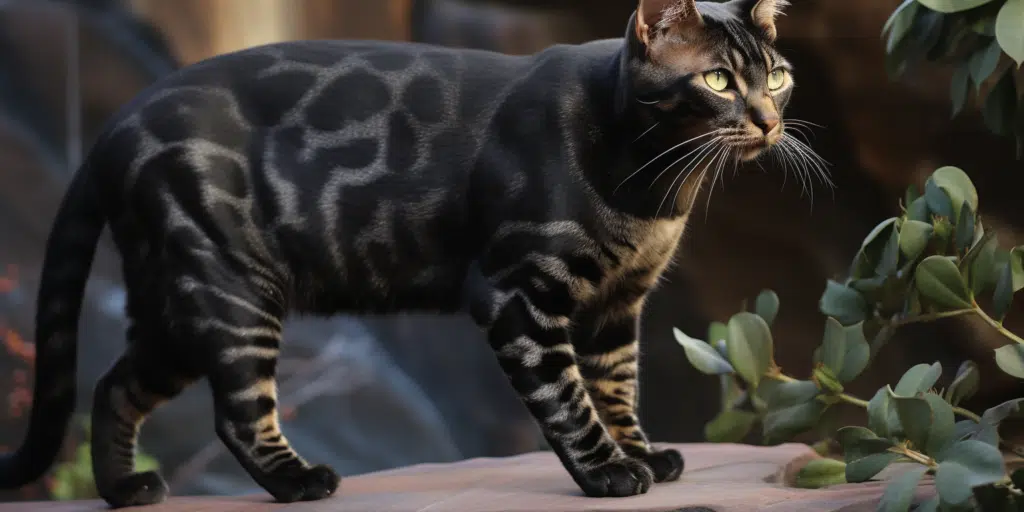
Love Of Water
Bengal cats have a strong propensity for water. This is due to their wild heritage, as their Asian Leopard Cat ancestors spent plenty of time in and around water.
Many Bengals have been known to enjoy playing in the shower or even taking a swim, despite not being technically “swimming cats”.
If you train your Bengal with water and give them access to clean and safe bodies of water, it’s quite likely that they will start to play and enjoy themselves immensely!
Trainability
Bengals may have a reputation for being mischievous and willful, but their intelligence makes them highly trainable. With patience and consistency, Bengal cats can learn to respond to simple verbal commands such as “come” or “no”.
With the right kind of reinforcement and positive rewards such as treats or praise, Bengal cats are capable of learning a variety of tricks that make them delightful companions.
Training your cat is an exercise in patience and commitment; they require more time than other breeds to learn simple tasks or tricks.
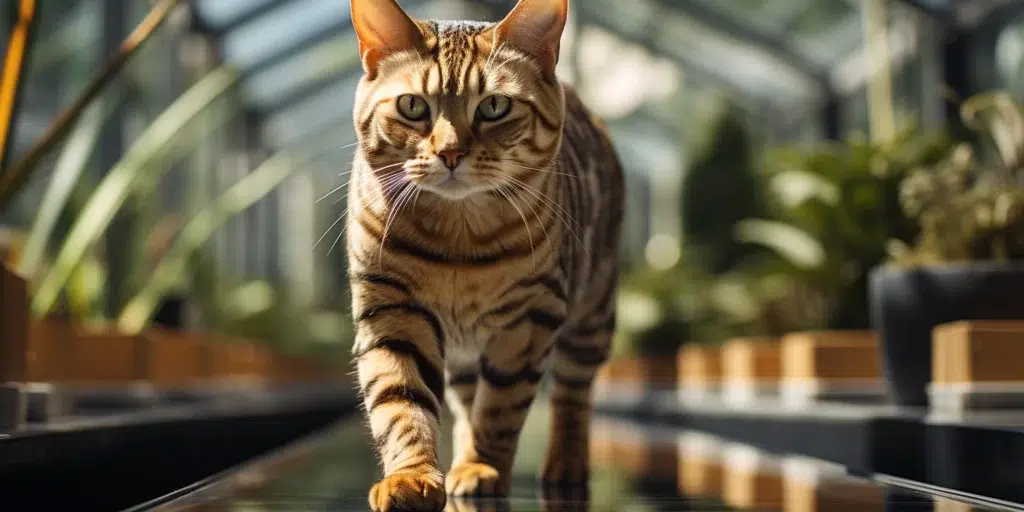
But with regular practice sessions, your furry friend will soon understand what you want from them. Plus, the bond between you and your cat will grow stronger through training sessions.
While some people might think Bengals are stubborn creatures that won’t listen to you no matter how hard you try, the truth is far from this misconception!
Adult Size
The average adult Bengal cat has a body length of 14 – 18 inches, not including the tail. Bengals can weigh anywhere from 8 to 15 pounds or more, depending on the size of the cat.
Males typically weigh 10 - 15 pounds while females tend to be slightly smaller at 8 -10 pounds.
Kittens usually gain about one pound per month so a four-month-old kitten will typically weigh around 4 pounds. But then they will grow at a slower rate until they reach adulthood.
These cats also have long tails that are thick at the base but get thinner toward the tip. This gives them an elegant look as they move gracefully through their environment!
Life Expectancy
Generally speaking, the life expectancy of a Bengal Cat can be anywhere from 12 – 16 years. This can vary depending on the individual cat’s genetics and overall health.
To ensure your Bengal Cat reaches its maximum lifespan, it is important to provide them with regular veterinary checkups, proper nutrition, and exercise.
Bengal Cat Care
Bengals are among the easier cats for you to care for. They’re quite easygoing and require minimal grooming, including fewer baths. However, you should consider a few things to ensure they remain in optimal health and appearance.
You usually don’t need to bathe them, but it’s crucial for you to brush their teeth daily to prevent periodontal disease. Trimming their nails every couple of weeks is also important for maintaining your furry friend’s hygiene.
When cleaning their eyes, gently wipe any discharge from the corners with a soft, damp cloth. This method helps prevent the spread of any infection.
Make checking their ears a part of your weekly routine. You can clean them with a cotton ball or a soft cloth dampened with a mixture of equal parts cider vinegar and warm water.
Providing chew toys and meat sticks can also help keep their teeth clean without needing toothpaste, which might not be suitable for cats.
Remember to keep their litter box immaculately clean. Bengals appreciate a clean and tidy litter area.
By following these tips, keeping your Bengal Cat clean will be a breeze for you.

Diet
Bengal cats require the same quality of nutrition as any other domesticated cat. A high-quality, balanced diet is important to ensure their health and well-being. It should contain a variety of proteins, carbohydrates, fats, vitamins, and minerals to meet their nutritional needs.
Experts recommend to feed your Bengal a raw food diet because it has a higher protein content, which is essential for maintaining their lean muscle mass and managing their weight healthily.
You can also find freeze-dried raw foods at pet stores, which provide all the benefits of a raw diet without the hassle of safely handling or storing fresh meat.
It’s best not to free-feed this breed as this can lead to overeating which may result in obesity. Instead, you should provide them measured meals throughout the day that provide just enough food for your Bengal cat’s energy levels.
It’s also important to ensure they have access to clean drinking water throughout the day. These cats need to stay hydrated at all times; especially during hot summer days when they need more drinking water than usual!
Ideally, try to place several water dishes around your house for easy access. Be sure to keep these bowls in areas where they often hang around or walk past.
In addition to having constant access to fresh water, you should also monitor your Bengal’s hydration levels regularly to ensure they drink the water.
You can do this by feeling their skin; if it feels dry or flaky then they may need more fluids! Also, look out for other signs such as weight loss or decreased appetite which could indicate dehydration in your Bengal Cat.
Regularly monitoring and providing enough fresh, clean water with a balanced diet will help keep your fur baby healthy and happy!
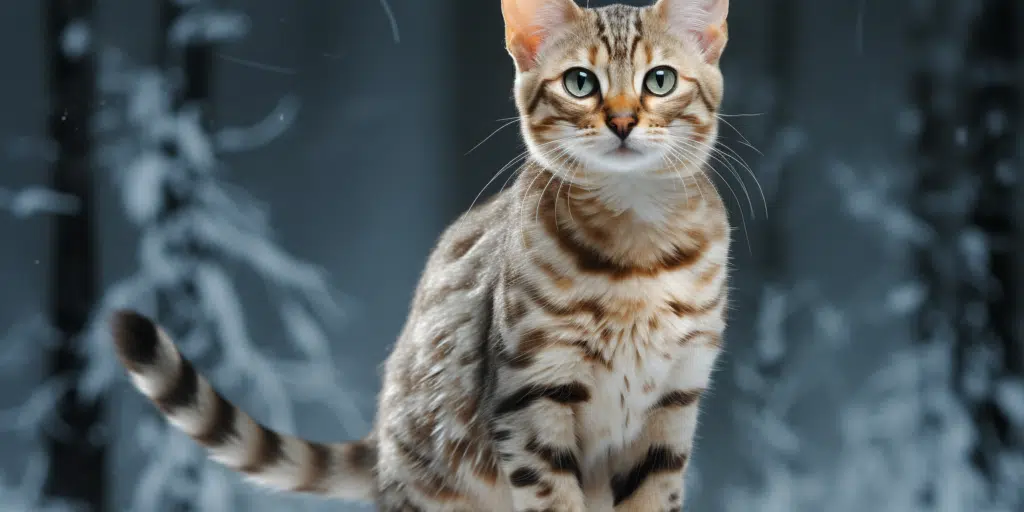
Related: Snow Bengal Cat: Types, Breed Info, Pictures & More!
Exercise Requirement
Bengals are very active cats and need plenty of exercise to stay healthy. These cats love to climb, run, jump, and explore their environment.
Regular playtime can help your Bengal cat maintain a healthy weight as well as reduce stress levels. Interactive activities such as chasing a laser pointer or feather toys will not only keep them entertained but also help them build strong muscles which are important for overall health.
Playing with your cat will also help them develop better social behavior towards humans and other animals in the household. When given plenty of opportunities to learn through play, these cats can become more confident around strangers as well. Additionally, regular physical activity can help strengthen the bond between you and your Bengal.
All their activity should be indoors only unless you are around or you have a large outdoor enclosure. By having them indoors you protect them from diseases passed on by other cats, attacks by dogs/coyotes, etc…
Shedding Levels
Let’s talk about shedding in Bengal cats. Bengals generally do not shed a lot compared to other breeds. However, you’ll notice that their shedding can vary, depending on several factors. Here’s a breakdown of what to expect at various stages of their life:
- Kitten to Adolescence – During this stage, Bengals typically shed very little. Their coat is still developing, and they maintain a sleek appearance without much loose fur.
- Adulthood – As Bengals mature, their shedding may increase slightly. However, Bengals are known for their short, pelt-like coats that don’t shed as much as other breeds, keeping shedding minimal.
- Senior Cats – In their senior years, Bengal cats might experience a bit more shedding. This can be due to various factors including changes in diet, health, and activity levels. Regular grooming can help manage shedding during this stage.
Remember, the amount a Bengal cat sheds can also be influenced by the seasons, their overall health, and diet. Regular grooming and proper nutrition can help manage shedding, keeping their coat healthy and vibrant throughout all stages of life.
Related: Is the Bengal Cat Hypoallergenic?
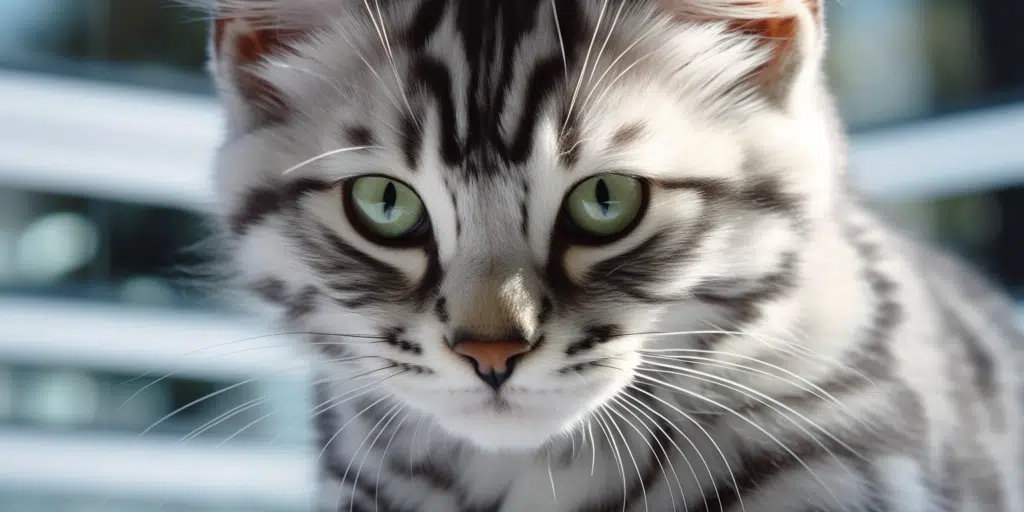
Health Issues
Bengal cats are generally a healthy breed, but they can be susceptible to certain diseases. The most common diseases seen in Bengal cats include:
- Distal neuropathy: Distal neuropathy is a nervous system disorder that causes weakness and can occur in Bengals as early as 1 year of age.
- Flat-chested kitten syndrome: Flat-chested kitten syndrome is a deformity that can range from mild to severe but usually shows no signs once the cat reaches maturity.
- Hip dysplasia: Hip dysplasia is an inherited condition that can cause lameness if left untreated.
- PK-deficiency: is an inherited red blood cell enzyme disorder that causes chronic hemolysis.
- Hypertrophic cardiomyopathy: A hypertrophic cardiomyopathy is a form of heart disease that has been linked to genetics in some breeds.
- Patellar luxation: Patellar luxation occurs when the kneecap becomes dislocated and can range from mild to severe with surgery being the best treatment option for those with more severe cases.
- Progressive retinal atrophy: Progressive retinal atrophy is an eye disease caused by degenerative changes in the retina which leads to blindness over time if not treated promptly.
- Intestinal Bowel Disease
Poor diet and living conditions can significantly affect a Bengal Cat’s health. A poor diet can lead to nutrient deficiencies, obesity, digestive issues, and other health problems.
Living conditions that are too cramped, too hot or too cold, or lack of cleanliness can lead to a weakening of the cat’s immune system and the development of infections and diseases.
To prevent poor health, it is important to provide a balanced and nutritious diet, as well as plenty of clean water, proper sanitation, and regular exercise.
Additionally, providing a safe and comfortable environment that is free from stressors can help to keep a Bengal Cat healthy and happy in the long run.
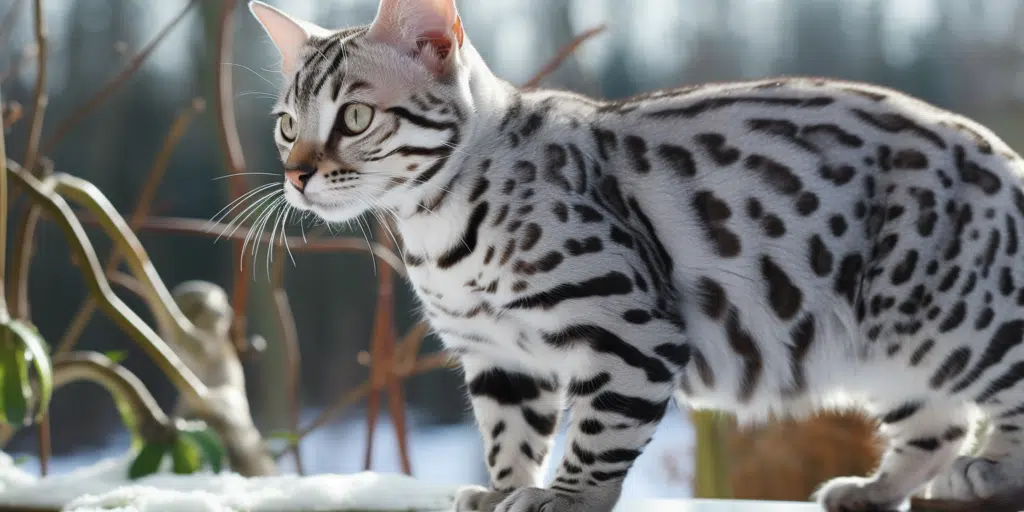
Buying Tips
- Consider adopting a Bengal Cat from a shelter or rescue organization rather than buying one from a breeder. This will help reduce the demand for cats bred inhumanely and can help save lives.
- If you still want to buy a kitten, it’s best to research potential breeders carefully first and be ready for the bengal expenses. This is to ensure they are reputable and provide healthy, well-socialized cats with verified pedigrees.
- Make sure you understand the costs associated with owning a Bengal Cat before making any purchase decisions. These include food, litter, veterinary expenses, as well as necessary toys and other supplies they will need.
- Have your home prepared for your new arrival before bringing them home. You can set up an area specifically for the cat that is away from any other pets if you have any.
- Spend some extra time getting to know your new cat before bringing them home. This is a great way to pick a kitten if the breeder lets you before purchasing them
Related: Amazing Bengal Cat Names & How To Select One!

Conclusion
Bengal Cats are a unique and fascinating breed that can make wonderful companions. They are active, intelligent, curious, and affectionate cats that thrive in an environment where they can explore their curiosity and receive plenty of attention from their owners.
Their exotic coats also make them stand out from other cats. With the proper care, these cats can live long healthy lives as part of your family for many years to come.
References And Useful Links: Prionailurus bengalensis, Bengal, Hypertrophic Cardiomyopathy